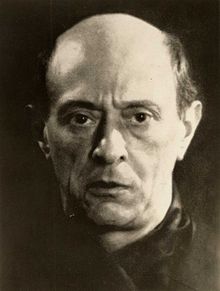Arnold Schoenberg
Bài này không có nguồn tham khảo nào. |
| Arnold Schoenberg | |
|---|---|
 | |
| Thông tin cá nhân | |
| Sinh | |
Tên khai sinh | Arnold Franz Walter Schönberg |
Ngày sinh | 13 tháng 9, 1874 |
Nơi sinh | Viên |
| Mất | |
Ngày mất | 13 tháng 7, 1951 |
Nơi mất | Los Angeles |
Nguyên nhân | nhồi máu cơ tim |
| An nghỉ | Nghĩa trang trung tâm Viên |
| Giới tính | nam |
| Quốc tịch | Áo, Hoa Kỳ, Đế quốc Áo-Hung, Đức |
| Nghề nghiệp | nhà soạn nhạc cổ điển, họa sĩ, nhà âm nhạc học, nhà lý luận âm nhạc, nhà văn, nhạc trưởng, nhà soạn nhạc, giáo viên âm nhạc, nghệ sĩ |
| Gia đình | |
Cha | Samuel Schönberg |
Hôn nhân | Gertrud Schoenberg, Mathilde Zemlinsky |
Con cái | Gertrud Schönberg, Georg Schönberg, Nuria Nono-Schönberg, Ronny Schönberg, Larry Schönberg |
| Thầy giáo | Alexander von Zemlinsky |
| Học sinh | Josef Rufer, Alban Berg, Viktor Ullmann, Hanns Eisler, Paul Pisk, Winfried Zillig, Ernst Krenek, John Cage, Anton Webern, Egon Wellesz, Eduard Steuermann, Rudolf Kolisch, Nikos Skalkottas, Lou Harrison, Robert Gerhard, Leon Kirchner, Erwin Stein, Sándor Jemnitz, Norbert von Hannenheim, Robert Erickson, Vilma von Webenau, Karl Rankl, Leonard Stein, Heinrich Jalowetz, Earl Kim, Edward Clark, René Leibowitz, Natalia Pravosudovich, Hans Swarowsky, Dika Newlin |
| Lĩnh vực | nhà soạn nhạc |
| Sự nghiệp nghệ thuật | |
| Năm hoạt động | 1897 – 1951 |
| Thể loại | âm nhạc cổ điển thế kỷ 20, opera, nhạc vô điệu tính, chủ nghĩa nối tiếp, nhạc cổ điển, chủ nghĩa biểu hiện, nhạc 12 tông |
| Nhạc cụ | dương cầm |
| Thành viên của | |
| Tác phẩm | Erwartung, Verklärte Nacht, Một người sống sót từ Warsaw |
| Có tác phẩm trong | |
| Giải thưởng | |
| Website | |
| https://www.schoenberg.org | |
| Arnold Schoenberg trên IMDb | |

Arnold Schoenberg (Arnold Schönberg, tiếng Đức: [ˈaːʁnɔlt ˈʃøːnbɛʁk] ⓘ; 1874–1951) là nhà soạn nhạc, nhà lý thuyết âm nhạc, nhạc trưởng, nhà sư phạm người Mỹ gốc Áo.
Thân thế sự nghiệp
[sửa | sửa mã nguồn]Schoenberg sinh năm 1874 tại thủ đô Viên của nước Áo. Ông tự học âm nhạc và có học phức điệu vài tháng với thầy Zemlinsky. Từ năm 1901, Schoenberg công tác chỉ huy dàn nhạc và giảng dạy tại Berrlin và Viên. Những năm 1901-1905, ông sống ở Berlin, lưu diễn với tư cách nhạc trưởng, một phần là để giới thiệu tác phẩm của mình. Từ 1915 đến 1917, ông tham gia quân đội. Năm 1918, về Viên, dạy học và nghiên cứu âm nhạc. Từ năm 1925, ông phụ trách lớp sáng tác nâng cao cua Viện Hàn lâm nghệ thuật Berlin. Sau, năm 1933, ông phải di tản từ Đức (Đảng Quốc xã nắm quyền lúc ấy)để sang Paris rồi sang sang nước Mỹ. Một năm sau, Shoenberg định cư ở Los Angeles. Trong khoảng 1936-1944, ông trở thành giáo sư của Đại học Tổng hợp California. Trong thời gian giảng dạy, ông đã đào tạo nên các nhà soạn nhạc có tên tuồi cua thế kỷ XX như Webern, Berg, Wellesz, Erwin Stein,... Ông mất năm 1951 tại Los Angeles, Hoa Kỳ.[1]
Phong cách sáng tác
[sửa | sửa mã nguồn]Trong giai đoạn sáng tác đầu tiên trong cuộc đời(1897-1907), Schoenberg là một trong những nhạc sĩ lãng mạn cuối thế kỷ XIX(cuối thời kỳ Lãng Mạn). Từ 1908-1921, ông chuyển sang thứ âm nhạc vô điệu tính, hoàn thiện cơ sở lý thuyết cho âm nhạc 12 cung;Schoenberg thuộc trường phái biểu hiện. Từ năm 1922 đến 1951, ông đưa ra hệ thống 12 cung thay cho hệ thống điệu tính. Đó là cơ sở đê rất nhiều nhà soạn nhạc thế kỷ XX có những tìm tòi mới mẻ. Như vậy, ông đã ảnh hưởng tới âm nhạc thế kỷ XX.[1]
Các tác phẩm
[sửa | sửa mã nguồn]Schoenberg đã sáng tác vở opera Moses và Aron và một số vở opera khác, rất nhiều tác phẩm cho dàn nhạc giao hưởng, trong đó có Giao hưởng thính phòng số 2 Op.38a(1939), Chủ đề và biến tấuOp.43a (1943).Những tác phẩm cho các giọng hát và dàn nhạc phải kể đến Pierrot Lunaire Op.21cho xướng ngôn viên,dàn hòa tấu thính phòng, Thánh thi hiện đại Op.50c cho hợp xướng và dàn nhạc(1950).Còn về nhạc thính phòng Schoenberg có tác phẩm Fantasy cho violin và piano cùng với các tác phẩm khác dành cho piano. Ngoài ra, ông còn có các ca khúc. Về nghiên cứu âm nhạc, Shoenberg có viết Luận về hòa thanh(1922), Những chức năng cấu trúc của hòa thanh(1954), Phong cách và ý tưởng(1972).[1]
Chú thích
[sửa | sửa mã nguồn]Tham khảo
[sửa | sửa mã nguồn]- Adorno, Theodor. 1967. Prisms, translated from the German by Samuel and Shierry Weber London: Spearman; Cambridge, MA: The MIT Press.
- Anon. 2001. "Arnold Schoenberg". Find-a-Grave (Accessed ngày 1 tháng 4 năm 2013).
- Anon. 2002. "Arnold Schönberg and His God Lưu trữ 2009-07-07 tại Wayback Machine". Vienna: Arnold Schönberg Center. (Accessed ngày 1 tháng 12 năm 2008)
- Beaumont, Antony. 2000. Zemlinsky. London: Faber and Faber. ISBN 0-571-16983-X Ithaca: Cornell University Press. ISBN 978-0-8014-3803-5.
- Buhle, Pal, and David Wagner. 2002. Radical Hollywood: The Untold Story Behind America's Favorite Movies. New York: The New Press. ISBN 1-56584-819-5
- Clausen, Detlev (2008). Theodor W. Adorno: One Last Genius, translated by Rodney Livingstone. Cambridge: Harvard University Press. ISBN 978-0-674-02618-6.
- Friedrich, Otto. 1986. City of Nets: A Portrait of Hollywood in 1940's [sic]. New York: Harper & Row. ISBN 0-06-015626-0. Reprinted, Berkeley and Los Angeles: University of California Press. ISBN 0-520-20949-4.
- Frisch, Walter. 1999. Schoenberg and His World. Princeton: Princeton University Press. ISBN 9780691048611.
- Genette, Gérard. 1997. Immanence and Transcendence, translated by G. M. Goshgarian. Ithaca: Cornell University Press. ISBN 0-8014-8272-0.
- Greissle-Schönberg, Arnold, and Nancy Bogen. [n.d.] Arnold Schönberg’s European Family Lưu trữ 2009-08-23 tại Wayback Machine (e-book). The Lark Ascending, Inc. (Accessed ngày 2 tháng 5 năm 2010)
- Foss, Hubert. 1951. "Schoenberg, 1874–1951" Musical Times 92, no. 1 (September): 401–403.
- Hailey, Christopher. 1993. Franz Schreker, 1878–1934: A Cultural Biography. Cambridge and New York: Cambridge University Press. ISBN 978-0-521-39255-6.
- Haimo, Ethan. 1990. Schoenberg's Serial Odyssey: The Evolution of his Twelve-Tone Method, 1914–1928. Oxford [England]: Clarendon Press; New York: Oxford University Press ISBN 0-19-315260-6.
- Lebrecht, Norman. 1985. The Book of Musical Anecdotes. New York: Simon and Schuster; London: Sphere Books. ISBN 0-02-918710-9
- Lebrecht, Norman. 2001. "Why We're Still Afraid of Schoenberg". The Lebrecht Weekly (8 July).
- Leeuw, Ton de. 2005. Music of the Twentieth Century: A Study of Its Elements and Structure, translated from the Dutch by Stephen Taylor. Amsterdam: Amsterdam University Press. ISBN 90-5356-765-8. Translation of Muziek van de twintigste eeuw: een onderzoek naar haar elementen en structuur. Utrecht: Oosthoek, 1964. Third impression, Utrecht: Bohn, Scheltema & Holkema, 1977. ISBN 90-313-0244-9.
- MacDonald, Malcolm. 2008. Schoenberg. The Master Musicians Series. Oxford and New York: Oxford University Press. ISBN 978-0-19-517201-0.
- Mahler, Alma. 1960. Mein Leben, with a foreword by Willy Haas. Frankfurt am Main: S. Fischer, My Life, My Loves: The Memoirs of Alma Mahler, St. Martin's Griffin (1958) PaperbackISBN 978-0312025403.
- Marquis Who's Who. n.d. (Who Was Who in America, Volume III {1951-1960}). Truy cập ngày 4 tháng 10 năm 2012.[cần chú thích đầy đủ]
- Neighbour, O[liver] W. (2001), "Schoenberg [Schönberg], Arnold (Franz Walter)". The New Grove Dictionary of Music and Musicians, second edition, edited by Stanley Sadie và John Tyrrell. London: Macmillan Publishers.
- Plush, Vincent. 1996. "They Could Have Been Ours[liên kết hỏng]", ABC Radio 24 Hours (January).
- Rosen, Charles. 1975. Arnold Schoenberg. New York: Viking Press. ISBN 0-670-13316-7 (pbk) ISBN 0-670-01986-0 (cloth). Reprinted 1996, with a new preface. Chicago: University of Chicago Press. ISBN 0-226-72643-6
- Ross, Alex. 2007. And the Rest Is Noise: Listening to the Twentieth Century. New York: Farrar, Straus, and Giroux, ISBN 978-0-374-24939-7
- Schonberg, Harold C. 1970. The Lives of the Great Composers. New York: W. W. Norton. ISBN 0-393-02146-7 (Revised ed., New York: W. W. Norton, 1980. ISBN 0-393-01302-2 Third ed. New York: W.W. Norton, 1997. ISBN 0-393-03857-2)
- Schoenberg, Arnold. 1922. Harmonielehre, third edition. Vienna: Universal Edition. (Originally published 1911). Translation by Roy E. Carter, based on the third edition, as Theory of Harmony. Berkeley, Los Angeles: University of California Press, 1978. ISBN 0-520-04945-4.
- Schoenberg, Arnold. 1959. Structural Functions of Harmony. Translated by Leonard Stein. London: Williams and Norgate; Revised edition, New York, London: W. W. Norton and Company 1969. ISBN 0-393-00478-3.
- Schoenberg, Arnold. 1964. Arnold Schoenberg Letters, selected and edited by Erwin Stein, translated from the original German by Eithne Wilkins and Ernst Kaiser. London: Faber. Paperback reprint, Berkeley: University of California Press, 1987. ISBN 978-0-520-06009-8.
- Schoenberg, Arnold. 1967. Fundamentals of Musical Composition. Edited by Gerald Strang, with an introduction by Leonard Stein. New York: St. Martin's Press. Reprinted 1985, London: Faber and Faber. ISBN 0-571-09276-4.
- Schoenberg, Arnold. 1975. Style and Idea: Selected Writings of Arnold Schoenberg. Edited by Leonard Stein, with translations by Leo Black. New York: St. Martins Press; London: Faber & Faber. ISBN 0-520-05294-3. Expanded from the 1950 Philosophical Library (New York) publication edited by Dika Newlin. The volume carries the note "Several of the essays...were originally written in German (translated by Dika Newlin)" in both editions.
- Schoenberg, Arnold. 1984. Style and Idea: Selected Writings, translated by Leo Black. Berkeley: California University Press.
- Shoaf, R. Wayne. 1992. "Satellite Collections in the Archive of the Arnold Schoenberg Institute". Journal of the Arnold Schoenberg Institute 15, no. 1 (June): 9–110.
- Silverman, Kenneth. 2010. Begin Again: A Biography of John Cage. New York: Alfred A. Knopf, Toronto: Random House. ISBN 978-1-4000-4437-5. Reprinted, Northwestern University Press, 2012.[cần chú thích đầy đủ]
- Steinberg, Michael. 1995. The Symphony: A Listener's Guide. New York: Oxford University Press. ISBN 0-19-506177-2 (cloth) ISBN 0-19-512665-3 (pbk).
- Strimple, Nick. 2005. Choral Music in the Twentieth Century. Portland, Oregon & Cambridge, UK: Amadeus. ISBN 1-57467-122-7.
- Stuckenschmidt, Hans Heinz. 1977. Schoenberg: His Life, World and Work. Translated from the German by Humphrey Searle. New York: Schirmer Books[cần định hướng].
- UCLA Department of Music. [2008]. "Facilities and Maintenance Lưu trữ 2005-10-25 tại Wayback Machine". (Accessed ngày 1 tháng 12 năm 2008)
- University of Southern California Thornton School of Music. [2008]. "Performance Halls and Studios Lưu trữ 2009-11-26 tại Wayback Machine". (Accessed ngày 1 tháng 12 năm 2008)
- Worldspace Radio. 2007. Maestro "Concert Hall Presentation". ngày 13 tháng 7 năm 2007; Featured piece.[cần dẫn nguồn]
Đọc thêm
[sửa | sửa mã nguồn]- Auner, Joseph. 1993. A Schoenberg Reader. New Haven: Yale University Press. ISBN 0-300-09540-6.
- Boulez, Pierre. 1991. "Schoenberg is Dead" (1952). In his Stocktakings from an Apprenticeship, collected and presented by Paule Thévenin, translated by Stephen Walsh, with an introduction by Robert Piencikowski, 209–14. Oxford: Clarendon Press; New York: Oxford University Press. ISBN 0-19-311210-8.
- Brand, Julianne, Christopher Hailey, and Donald Harris (editors). 1987. The Berg-Schoenberg Correspondence: Selected Letters. New York, London: W. W. Norton and Company. ISBN 0-393-01919-5.
- Byron, Avior. 2006. "The Test Pressings of Schoenberg Conducting Pierrot lunaire: Sprechstimme Reconsidered". Music Theory Online 12, no. 1 (February). http://www.societymusictheory.org/mto/issues/mto.06.12.1/mto.06.12.1.byron_frames.html Lưu trữ 2007-06-03 tại Wayback Machine
- Everdell, William R.. 1998 The First Moderns: Profiles in the Origins of Twentieth-Century Thought. Chicago: University of Chicago Press.
- Eybl, Martin. 2004. Die Befreiung des Augenblicks: Schönbergs Skandalkonzerte von 1907 und 1908: eine Dokumentation. Wiener Veröffentlichungen zur Musikgeschichte 4. Vienna, Cologne, Weimar: Böhlau. ISBN 3-205-77103-6.
- Gur, Golan. 2009. "Arnold Schoenberg and the Ideology of Progress in Twentieth-Century Musical Thinking". Search: Journal for New Music and Culture 5 (Summer). Online journal (Accessed ngày 17 tháng 10 năm 2011).
- Hyde, Martha M. 1982. Schoenberg's Twelve-Tone Harmony: The Suite Op. 29 and the Compositional Sketches. Studies in Musicology, series edited by George Buelow. Ann Arbor: UMI Research Press. ISBN 0-8357-1512-4.
- Kandinsky, Wassily. 2000. "Arnold Schönberg als Maler/Arnold Schönberg as Painter". Journal of the Arnold Schönberg Center, no. 1:131–76.
- Meyer, Esther da Costa. 2003. "Schoenberg's Echo: The Composer as Painter". In Schoenberg, Kandinsky, and the Blue Rider, edited by Fred Wasserman and Esther da Costa Meyer, foreword by Joan Rosenbaum, preface by Christian Meyer. London and New York: Scala. ISBN 1-85759-312-X
- Rollet, Philippe (ed.). 2010. Arnold Schönberg: Visions et regards, with a preface by Frédéric Chambert and Alain Mousseigne. Montreuil-sous-Bois: Liénart. ISBN 978-2-35906-028-7.
- Shawn, Allen. 2002. Arnold Schoenberg's Journey. New York: Farrar Straus and Giroux. ISBN 0-374-10590-1.
- Weiss, Adolph. 1932. "The Lyceum of Schonberg", Modern Music 9, no. 3 (March–April): 99–107.
- Wright, James K. 2007. Schoenberg, Wittgenstein, and the Vienna Circle. Bern: Verlag Peter Lang. ISBN 978-3-03911-287-6.
- Wright, James and Alan Gillmor (eds.). 2009. Schoenberg's Chamber Music, Schoenberg's World. New York: Pendragon Press. ISBN 978-1-57647-130-2.
Do Schoenberg ghi âm
[sửa | sửa mã nguồn]- recordings at archive.org
- Video and audio as part of musicology studies Lưu trữ 2011-05-27 tại Wayback Machine
- Danh sách này không đầy đủ, bạn cũng có thể giúp mở rộng danh sách.
Liên kết ngoài
[sửa | sửa mã nguồn]- Arnold Schoenberg Center in Vienna
- Biographical Timeline at the Arnold Schoenberg Center Lưu trữ 2014-11-06 tại Wayback Machine
- (tiếng Pháp) Tiểu sử của Arnold Schoenberg, tại website của IRCAM.
- Complete Schoenberg Discography & List of Works Lưu trữ 2007-11-27 tại Wayback Machine
- Music in the Air: 6 Kleine Klavierstucke op.19
- The Lied, Art Song, and Choral Texts Archive Created and maintained by Emily Ezust Lưu trữ 2011-05-17 tại Wayback Machine Texts of the poems set in music by Schoenberg with translations in various languages.
- Các bài viết về Schoenberg
- Contemporary account on Schoenberg by James Huneker from his work Ivory Apes and Peacocks (1917)
- An Interview with Schoenberg's children Lưu trữ 2012-07-28 tại Wayback Machine (2008) by Avior Byron
- "How Arnold Schoenberg Became Lonely: Imagination versus Reality", Sabine Feisst, Berfrois (2011)
 GIẢM
35%
GIẢM
35%
![[Review sách] Đến lượt bạn làm thần rồi đấy](https://down-bs-vn.img.susercontent.com/vn-11134207-7r98o-lnawq9fp0v712d.webp) GIẢM
20%
GIẢM
20%
 GIẢM
24%
GIẢM
24%
 GIẢM
39%
GIẢM
39%
 GIẢM
10%
GIẢM
10%




